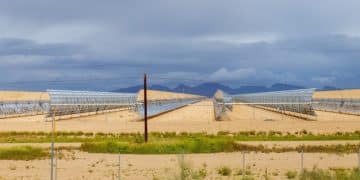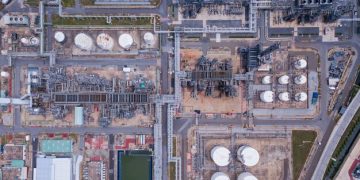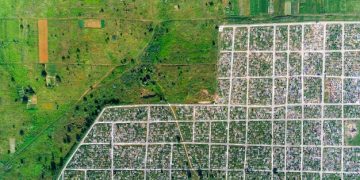Drone Tech: Revolutionizing Solar Panel Maintenance & Efficiency
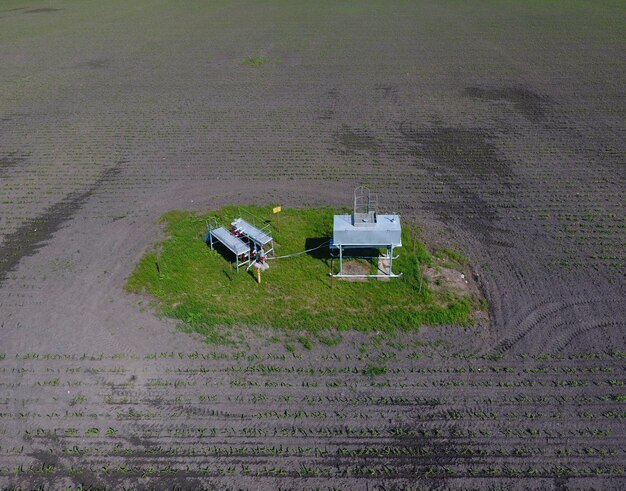
Drones are significantly improving solar panel maintenance and efficiency by providing rapid and precise aerial inspections, thermal imaging for defect detection, and enhanced data collection, ultimately reducing operational costs and maximizing energy output.
The intersection of drone technology and solar energy is creating a new era of efficiency and cost-effectiveness. How are drones being used to improve solar panel maintenance and efficiency? They are transforming how solar farms are inspected, maintained, and optimized, offering capabilities that were previously expensive, time-consuming, or simply impossible.
How are Drones Revolutionizing Solar Panel Inspections?
Solar panel inspections are critical to ensure optimal performance and longevity of solar farms. Traditionally, these inspections involved manual labor, often requiring technicians to physically climb onto rooftops or traverse large solar fields. This process was not only time-consuming but also posed safety risks and limitations in coverage.
Drones have emerged as a game-changing technology, offering a faster, safer, and more comprehensive alternative. By equipping drones with high-resolution cameras and thermal imaging sensors, operators can now conduct aerial inspections with unparalleled efficiency.
Enhanced Speed and Coverage
One of the primary advantages of using drones for solar panel inspections is the significant increase in speed and coverage. A single drone can inspect hundreds of solar panels in a matter of hours, a task that would take days or even weeks with traditional methods.
Reduced Downtime and Operational Costs
Drones enable rapid detection of issues, reducing the time solar panels are out of service. This quicker identification minimizes energy production losses and lowers operational expenses associated with lengthy manual inspections.
- Faster Data Collection: Drones can quickly capture vast amounts of data, offering more complete views than manual methods.
- Cost-Effective Solution: Deploying drones minimizes labor costs and reduces the necessity for costly equipment.
- Improved Safety: By removing the requirement for physical inspections, drones considerably lower the risk of accidents.
In summary, drones are revolutionizing solar panel inspections by offering enhanced speed, improved coverage, reduced downtime, and lower operational costs. Their ability to provide detailed aerial imagery and thermal data is transforming how solar farms are maintained and optimized.
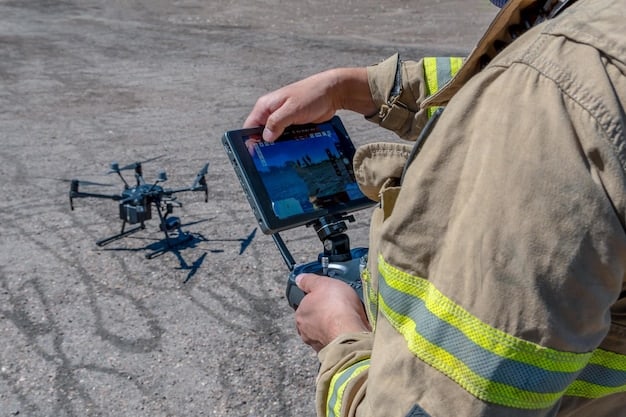
Thermal Imaging: Detecting Defects with Precision
Thermal imaging is a crucial component of modern solar panel maintenance. Traditional visual inspections can often miss subtle defects that are not immediately apparent to the naked eye. Thermal anomalies, such as hotspots, can indicate underlying issues that, if left unaddressed, can lead to significant energy losses and potential safety hazards.
Drones equipped with thermal cameras are capable of detecting these thermal anomalies with remarkable precision, allowing for proactive maintenance and preventing more serious problems from developing.
Identifying Hotspots and Micro-Cracks
Hotspots are areas on a solar panel that exhibit unusually high temperatures. These can be caused by various factors, including manufacturing defects, micro-cracks, or obstructions that impede the flow of electricity. Thermal imaging enables operators to quickly identify these hotspots, allowing them to pinpoint the exact location of the defect.
Assessing Cell Performance
Thermal imaging also plays a crucial role in assessing the overall performance of individual solar cells. By analyzing the temperature distribution across the panel, inspectors can identify cells that are underperforming or failing altogether. This information is invaluable for optimizing panel placement and maximizing energy output.
- Enhanced Defect Detection: Thermal cameras can detect problems invisible to the naked eye.
- Preventive Maintenance: Early detection of hotspots and micro-cracks minimizes potential long-term harm.
- Optimized Performance: Identification of underperforming cells enables quick performance maximization.
Overall, thermal imaging provided by drones offers a precise and efficient method for detecting defects in solar panels. This technology allows for proactive maintenance, preventing significant energy losses and ensuring the longevity of solar installations.
Data Collection and Analysis: How Drones Provide Insights
Effective solar panel maintenance is not just about detecting individual defects; it’s also about collecting and analyzing data to identify trends, optimize performance, and make informed decisions. Drones can gather comprehensive data in a fraction of the time compared to traditional methods, providing valuable insights that can significantly improve the efficiency of solar farms.
The data collected by drones can be used to create detailed reports, generate predictive models, and optimize maintenance schedules. By leveraging this information, operators can make data-driven decisions that maximize energy output and minimize operational costs.
Generating Detailed Reports
Drones capture high-resolution images and thermal data, which can be compiled into detailed reports for analysis. These reports provide a visual record of the condition of each solar panel, allowing operators to track changes over time and identify potential issues before they escalate.
Predictive Modeling
The data collected can be used to create predictive models that forecast future performance and identify potential areas of concern. By analyzing historical data and current conditions, these models can predict when maintenance is required, allowing operators to schedule repairs proactively.
- Comprehensive Data: Drones gather extensive visual and thermal data.
- Trend Identification: Data analysis finds patterns and potential problems.
- Optimized Maintenance: Predictive models forecast maintenance requirements.
In conclusion, data collection and analysis are crucial aspects of solar panel maintenance, and drones excel at providing valuable insights in this area. Their ability to gather comprehensive data and generate predictive models enables operators to make data-driven decisions that improve efficiency and reduce costs.
Cost Savings and ROI of Drone-Based Maintenance
One of the most compelling reasons to adopt drone-based maintenance for solar panels is the potential for significant cost savings and a high return on investment (ROI). While the initial investment in drone technology may seem daunting, the long-term benefits far outweigh the costs. Drones reduce labor expenses, minimize downtime, and prevent costly repairs, resulting in substantial savings over the lifespan of a solar farm.
The quantifiable savings from drone-based maintenance can be attributed to several factors, including reduced labor costs, faster inspection times, and the prevention of major equipment failures.
Reduced Labor Costs
Traditional solar panel inspections require a team of technicians to physically inspect each panel. This can be a labor-intensive and time-consuming process. Drones, on the other hand, can be operated by a single pilot, significantly reducing labor costs.
Minimizing Downtime
Drones enable rapid detection of defects, minimizing the time solar panels are out of service. This quicker identification reduces energy production losses and lowers operational expenses associated with lengthy manual inspections.
- Lower Labor Costs: Requires only a single drone pilot.
- Reduced Downtime: Quick defect detection minimizes service outages.
- Major Failure Prevention: Proactive maintenance keeps significant damage at bay.
To summarize, the adoption of drone-based maintenance for solar panels offers significant cost savings and a high ROI. By reducing labor costs, minimizing downtime, and preventing major equipment failures, drones provide a cost-effective solution for maintaining and optimizing solar farm performance.
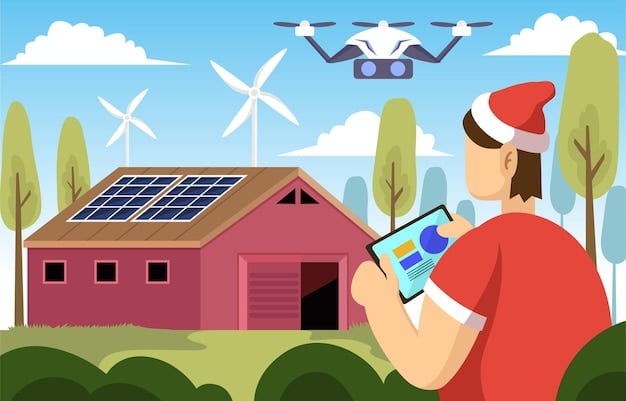
Regulatory Landscape: Understanding Drone Operations for Solar Farms
Operating drones for commercial purposes, including solar panel maintenance, is subject to various regulations and guidelines. Understanding the regulatory landscape is essential to ensure compliance and avoid potential fines or penalties. In the United States, the Federal Aviation Administration (FAA) regulates drone operations, setting standards for registration, certification, and operational requirements.
Navigating the regulatory landscape requires careful planning and adherence to established guidelines. Operators must obtain the necessary certifications, follow operational restrictions, and ensure that their drone operations comply with all applicable FAA regulations.
FAA Regulations
The FAA requires all commercial drone pilots to obtain a Remote Pilot Certificate. This certification involves passing a knowledge test and meeting certain eligibility requirements. Additionally, drone operators must adhere to operational restrictions, such as altitude limits, airspace restrictions, and daylight-only operations.
Local and State Regulations
In addition to federal regulations, drone operations may also be subject to local and state laws. Some jurisdictions may have restrictions on drone flights over private property or near sensitive infrastructure. It is important to research and comply with all applicable local and state regulations.
- FAA Compliance: Necessary to adhere to federal drone directives.
- Certification Importance: Pilots need to secure a Remote Pilot Certificate to operate legally.
- Regional Compliance: Must stick to local and state drone regulations.
In conclusion, understanding the regulatory landscape is crucial for drone operations in solar farms. Compliance with FAA regulations, as well as local and state laws, ensures the safety and legality of drone-based maintenance activities.
Future Trends: Advancements in Drone Technology for Solar Panel Maintenance
The field of drone technology is constantly evolving, and advancements are continually being made to improve the capabilities and efficiency of drones for solar panel maintenance. Future trends in this area include advancements in sensor technology, autonomy, and data analytics.
Staying abreast of these emerging trends is essential for solar farm operators looking to maximize the benefits of drone-based maintenance. By adopting new technologies and techniques, operators can further optimize their maintenance practices and improve the overall performance of their solar installations.
Advancements in Sensor Technology
Future drones will feature more advanced sensors, including higher-resolution cameras, improved thermal imaging capabilities, and specialized sensors for detecting specific types of defects. These advancements will enable more precise and comprehensive inspections.
Increased Autonomy
Advancements in artificial intelligence and machine learning are paving the way for more autonomous drone operations. Future drones will be able to navigate solar farms autonomously, detect defects without human intervention, and generate reports automatically. This increased autonomy will further reduce labor costs and improve efficiency.
- Improved Sensors: Newer, more comprehensive drone sensors are on the way.
- Increased Autonomy: AI-driven drones will streamline inspections.
- Enhanced Analytics: Analytics will lead to predictive maintenance measures.
In summary, the future of drone technology for solar panel maintenance is bright, with ongoing advancements promising to improve efficiency, reduce costs, and enhance the overall performance of solar installations. Staying informed about these trends and adopting new technologies will be key to maximizing the benefits of drone-based maintenance.
| Key Point | Brief Description |
|---|---|
| 🚀 Faster Inspections | Drones inspect solar panels much faster than traditional methods. |
| 🌡️ Thermal Imaging | Drones use thermal cameras to detect hotspots and defects. |
| 💰 Cost Savings | Drones reduce labor and downtime, saving costs. |
| 📈 Increased Efficiency | Regular drone inspections maintain optimal panel performance. |
Frequently Asked Questions
▼
Drones offer faster inspections, thermal imaging for defect detection, reduced labor costs, and improved safety compared to traditional methods.
▼
Thermal imaging detects hotspots and other thermal anomalies, indicating defects or performance issues that are not visible to the naked eye.
▼
Drone operations are subject to FAA regulations, including the need for a Remote Pilot Certificate, as well as local and state laws governing drone flights.
▼
Drones collect high-resolution images and thermal data, which can be analyzed to identify trends, optimize performance, and make informed maintenance decisions.
▼
Future advancements include higher-resolution sensors, increased autonomy, and enhanced data analytics, leading to more precise and efficient solar panel inspections.
Conclusion
As drone technology continues to evolve, its integration into solar panel maintenance practices will undoubtedly grow. The benefits of faster inspections, precise defect detection, and significant cost savings make drones an invaluable tool for optimizing solar farm performance. Embracing these advancements will ensure the continued efficiency and reliability of solar energy as a sustainable power source.
